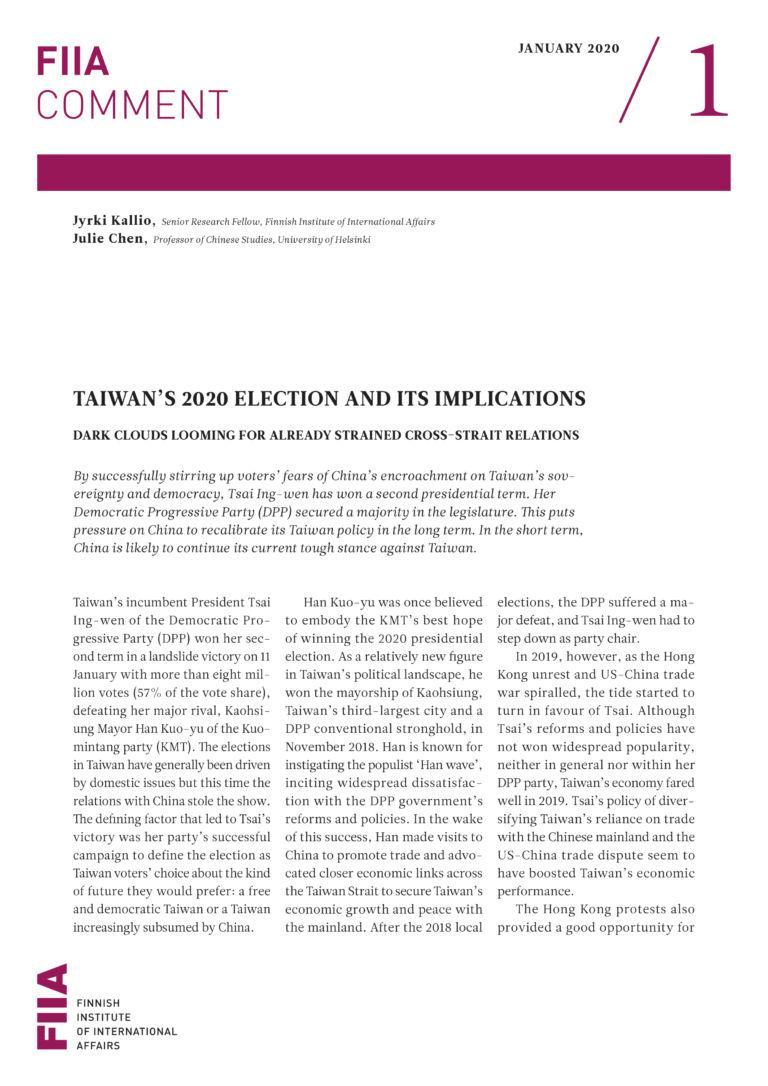
By successfully stirring up voters’ fears of China’s encroachment on Taiwan’s sovereignty and democracy, Tsai Ing-wen has won a second presidential term. Her Democratic Progressive Party (DPP) secured a majority in the legislature. This puts pressure on China to recalibrate its Taiwan policy in the long term. In the short term, China is likely to continue its current tough stance against Taiwan.
Taiwan’s incumbent President Tsai Ing-wen of the Democratic Progressive Party (DPP) won her second term in a landslide victory on 11 January with more than eight million votes (57% of the vote share), defeating her major rival, Kaohsiung Mayor Han Kuo-yu of the Kuomintang party (KMT). The elections in Taiwan have generally been driven by domestic issues but this time the relations with China stole the show. The defining factor that led to Tsai’s victory was her party’s successful campaign to define the election as Taiwan voters’ choice about the kind of future they would prefer: a free and democratic Taiwan or a Taiwan increasingly subsumed by China.
Han Kuo-yu was once believed to embody the KMT’s best hope of winning the 2020 presidential election. As a relatively new figure in Taiwan’s political landscape, he won the mayorship of Kaohsiung, Taiwan’s third-largest city and a DPP conventional stronghold, in November 2018. Han is known for instigating the populist ‘Han wave’, inciting widespread dissatisfaction with the DPP government’s reforms and policies. In the wake of this success, Han made visits to China to promote trade and advocated closer economic links across the Taiwan Strait to secure Taiwan’s economic growth and peace with the mainland. After the 2018 local elections, the DPP suffered a major defeat, and Tsai Ing-wen had to step down as party chair.
In 2019, however, as the Hong Kong unrest and US-China trade war spiralled, the tide started to turn in favour of Tsai. Although Tsai’s reforms and policies have not won widespread popularity, neither in general nor within her DPP party, Taiwan’s economy fared well in 2019. Tsai’s policy of diversifying Taiwan’s reliance on trade with the Chinese mainland and the US-China trade dispute seem to have boosted Taiwan’s economic performance.
The Hong Kong protests also provided a good opportunity for Tsai’s DPP to exercise the party’s greatest strength, as it has traditionally been seen as standing for Taiwan’s sovereignty in defiance of China’s pressure to unify the island with the mainland. The DPP campaigned to spread awareness of China’s interference in Taiwan’s elections, claiming that Han had obtained support from China to win popularity and visibility in the social and traditional media. This succeeded in undermining Han’s credibility in the minds of Taiwan’s electorate. The DPP appears to have succeeded in persuading young voters that their votes were about securing a free and democratic Taiwan. This is related to the trend of changing identities: opinion polls show that a growing majority of young Taiwanese no longer feel any affinity with China.
In the parallel legislature election, the DPP also managed to secure a majority for the second time. Nevertheless, Tsai’s second term will still be marked by many wrestling bouts with the legislature. According to Taiwan’s constitutional design, the legislature will be able to restrain the president’s power. There is internal disunity both among DPP legislators and between Tsai and DPP members, which was most clearly manifested last year with the legalization of same-sex marriage, something that Tsai supported but which many DPP members and legislators did not. Hence, much bargaining between the executive and legislative arms will continue.
Internally, the overall results of the presidential and legislature elections also point to the challenge that the old KMT party is facing. The KMT lacks a sufficient number of younger generation politicians that would help the party win back its rule of Taiwan. Han’s popularity won him temporary support within the party but, ultimately, KMT members were not unanimous in their acceptance of the new breed of politician that Han represents. This created a rift within the party that ultimately weakened the KMT’s prospects of an electoral victory. Nevertheless, it may be too early to predict whether the KMT will split or lose enough of its support base to become marginalized in Taiwanese politics.
For Beijing, the election result signifies a defeat of its Taiwan policy over the past few years. Beijing will have to recalibrate its approach as a consequence. In the short term, it is likely that Beijing will maintain its tough stance towards the island or recalibrate its Taiwan policy to tighten already strained relations. This would include continuing to put an end to official dialogues, squeezing Taiwan’s already limited international space, and reducing Taiwan’s few remaining diplomatic allies. It remains to be seen whether Beijing will continue to work through maintaining good relations with the KMT in the longer term, or whether it will come to the conclusion that this amounts to flogging a dead horse.
In the case of the latter, it would be rational for Beijing to engage in dialogue with the DPP. However, this would require completely new and innovative thinking, which would probably move the goal of reunification further into the future than Beijing is willing to wait for. Moreover, the US remains in a pivotal position in the relations between China and Taiwan. Tsai has generally been seen as the US’s preferred candidate for Taiwan’s presidency. However, it is uncertain how the US will step up its support for Taiwan when Tsai faces increasing pressure from China. The big question lingering in the background is whether the US would come to Taiwan’s aid should Beijing attempt to bring about reunification by military means.







